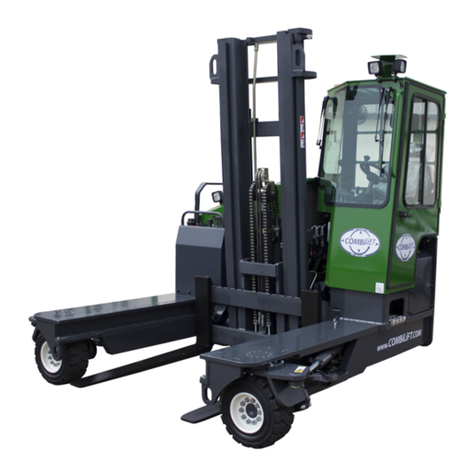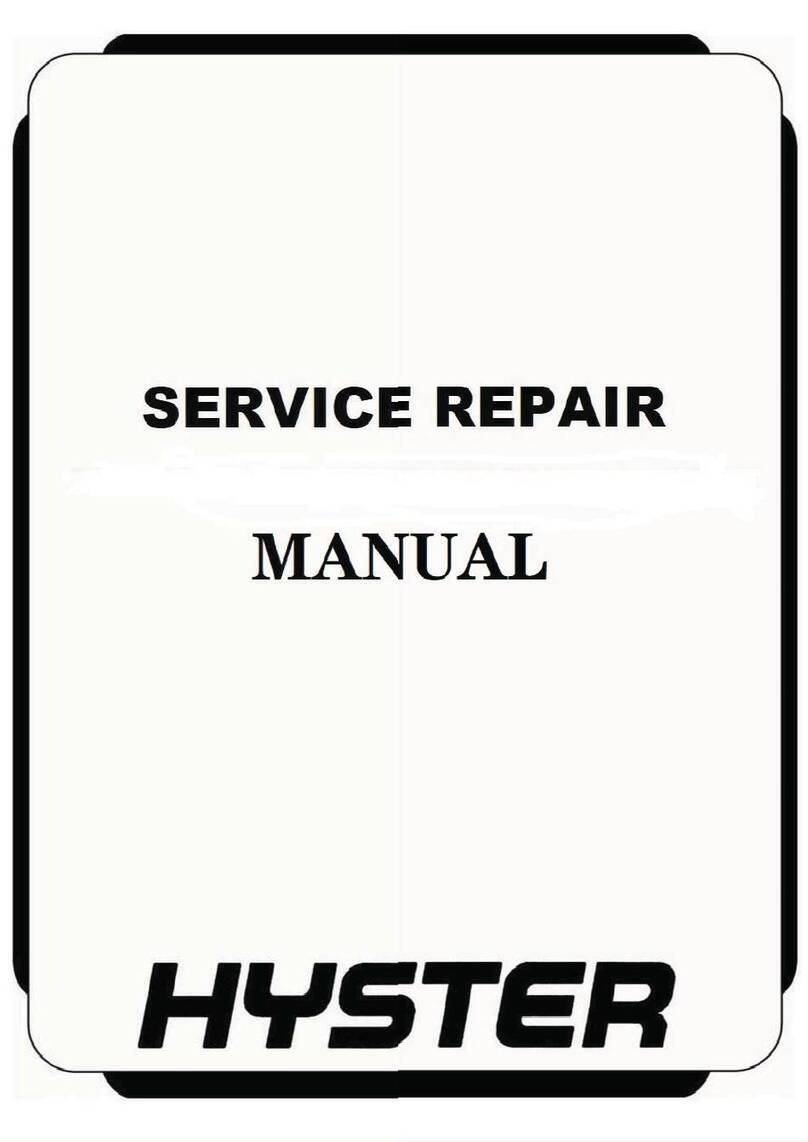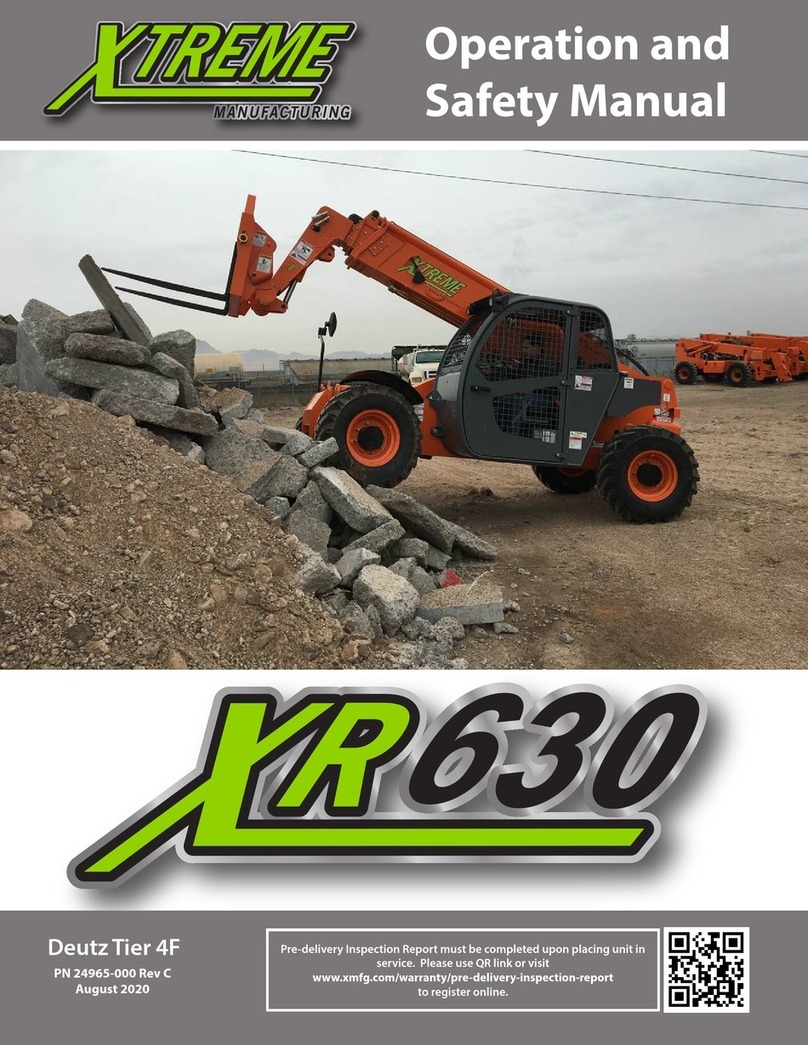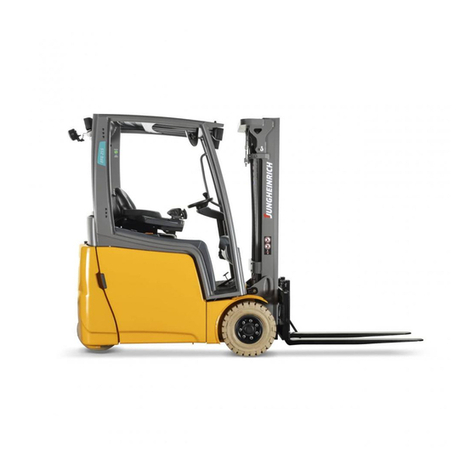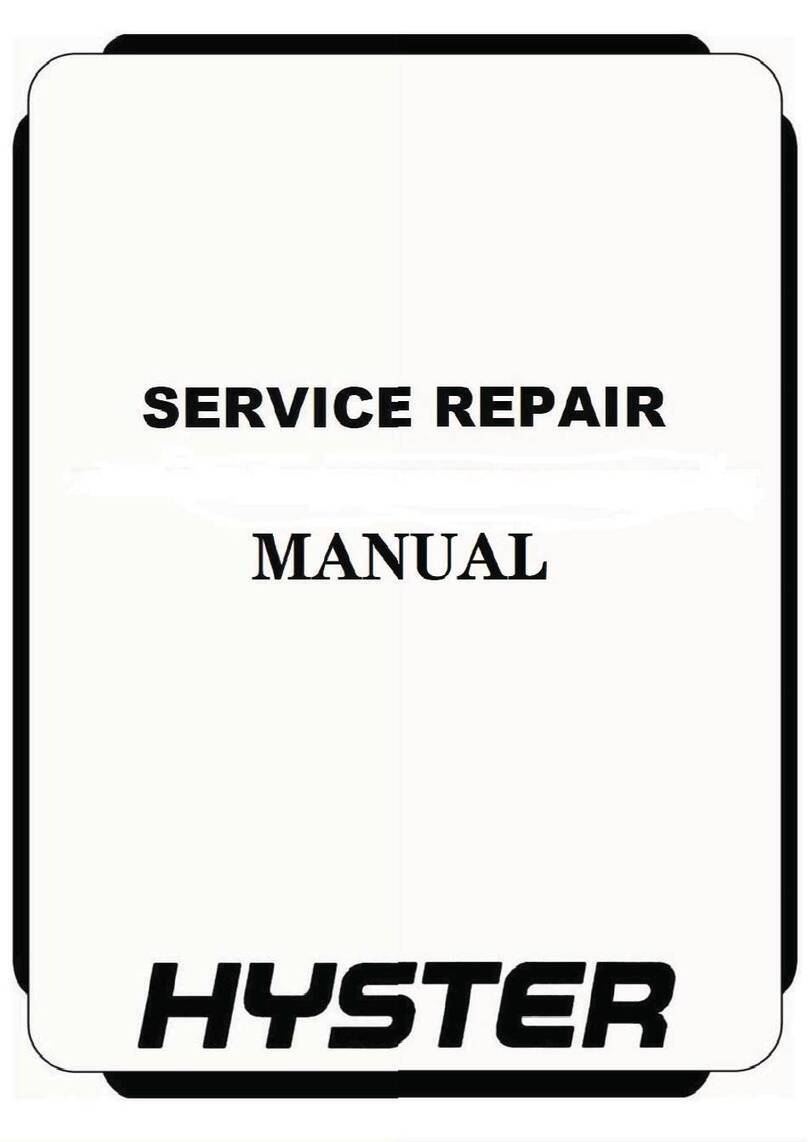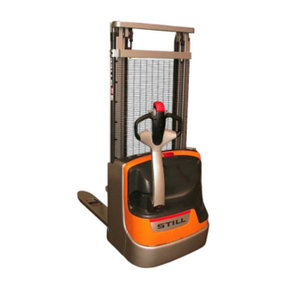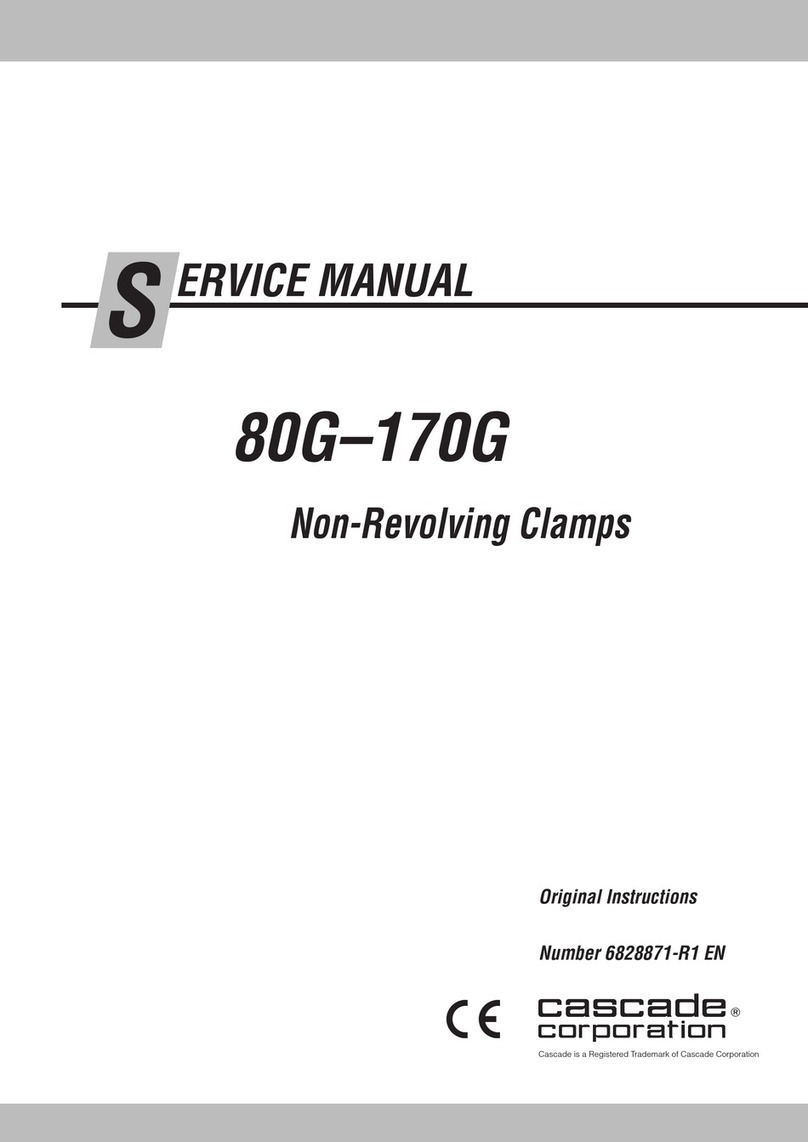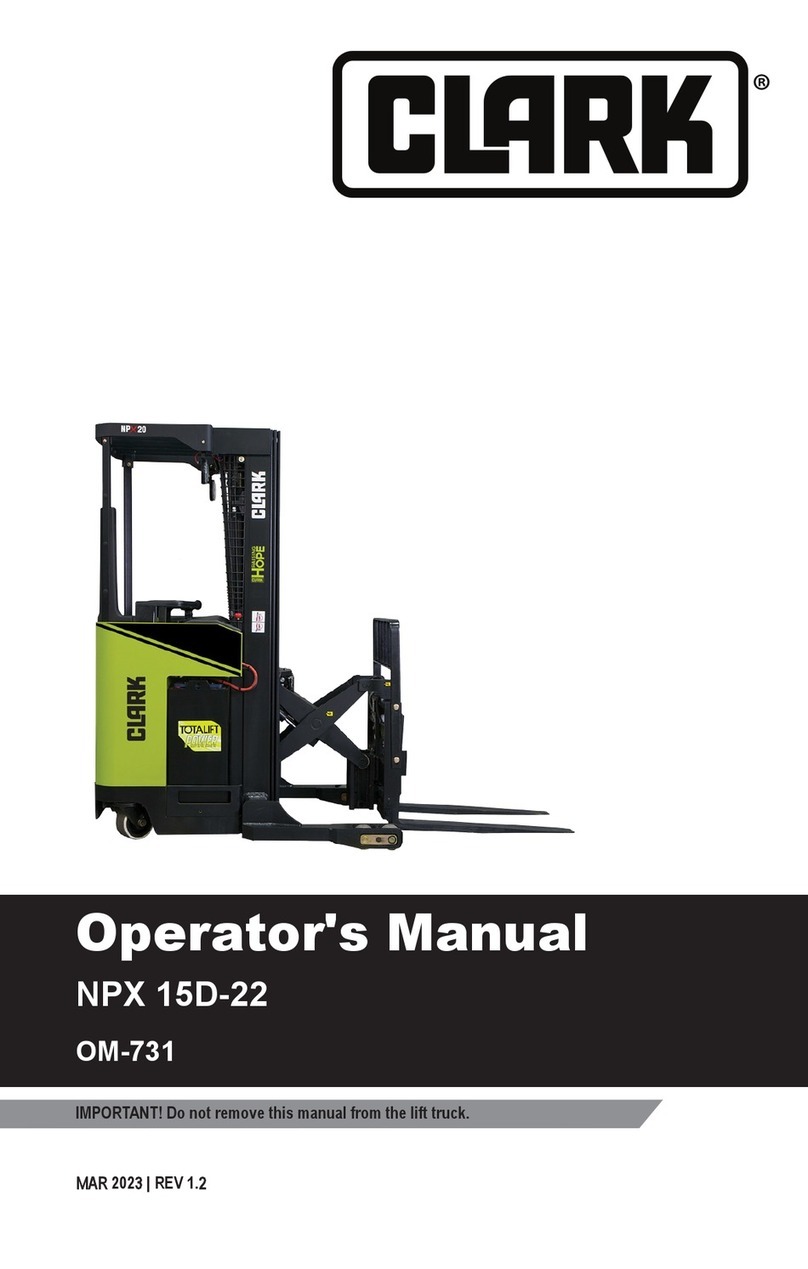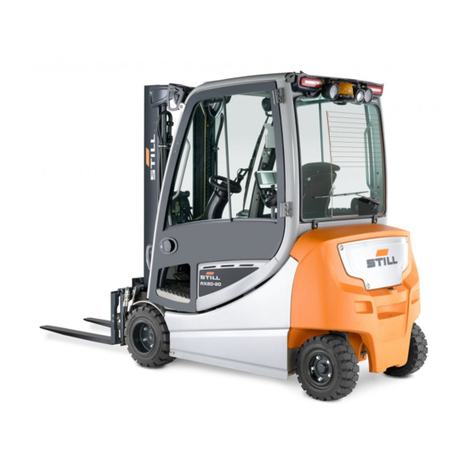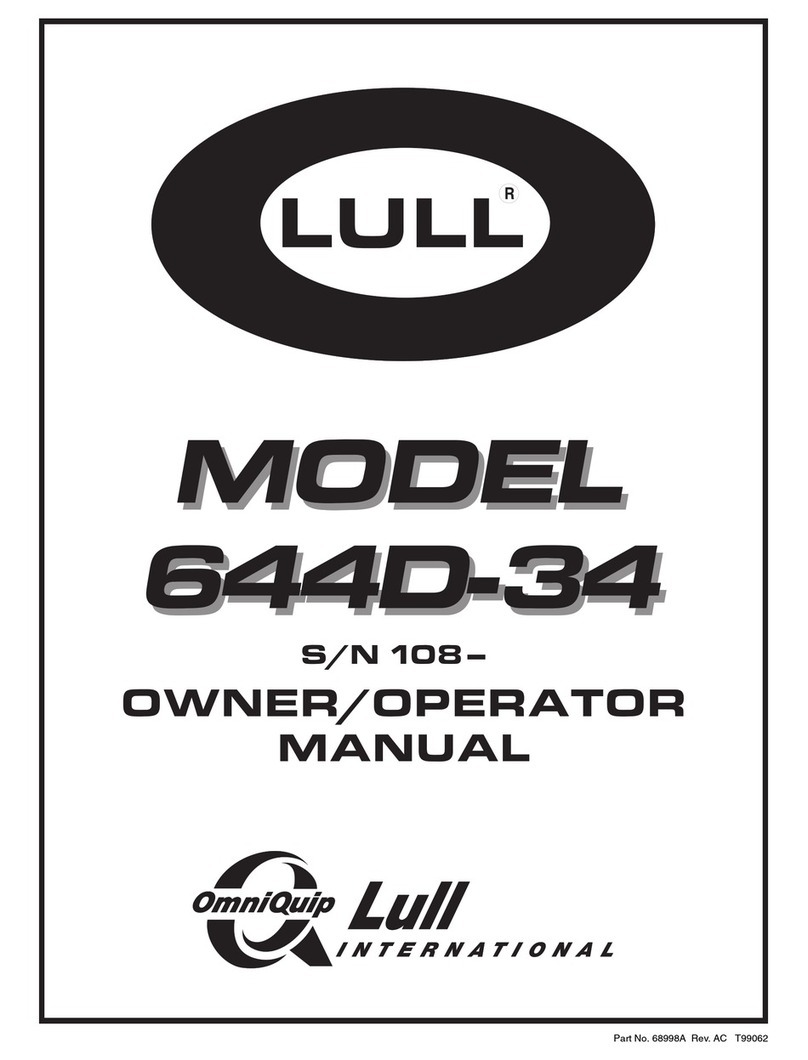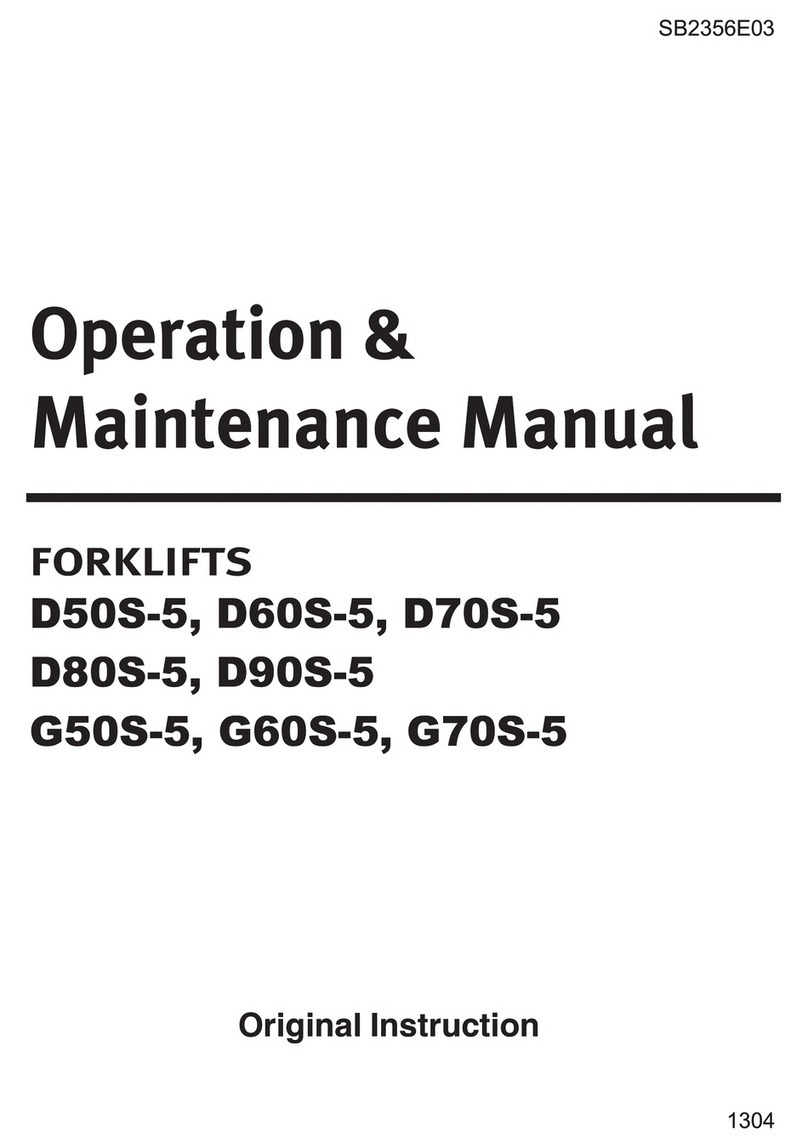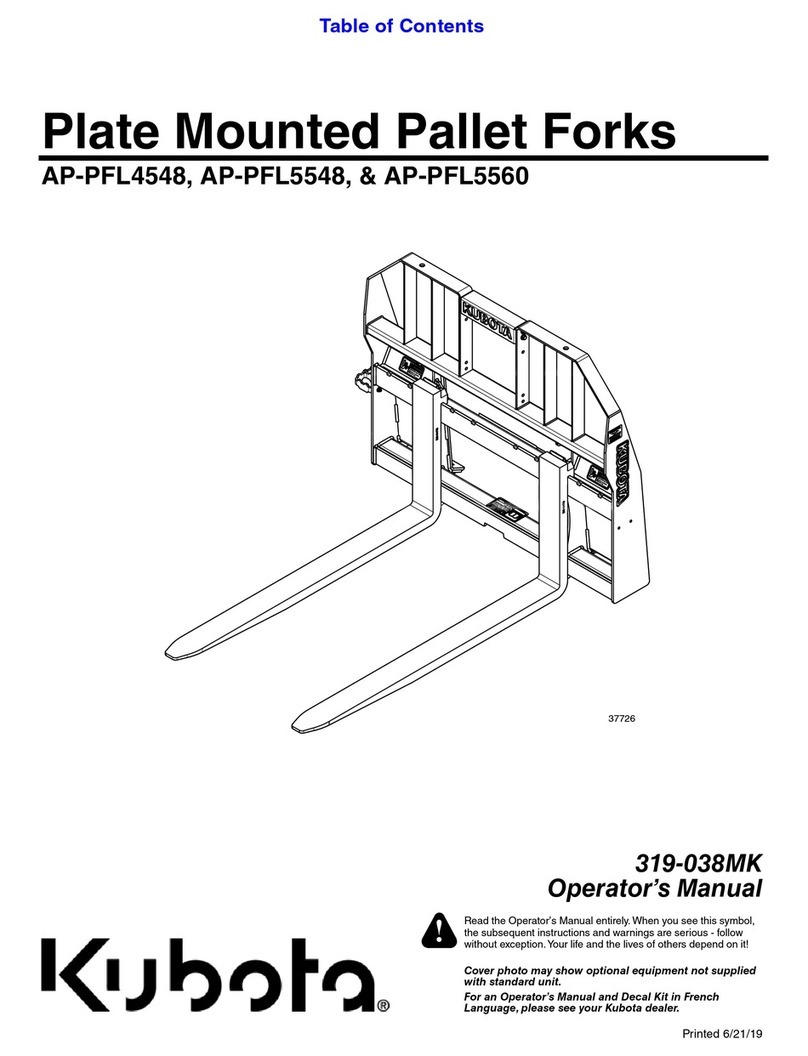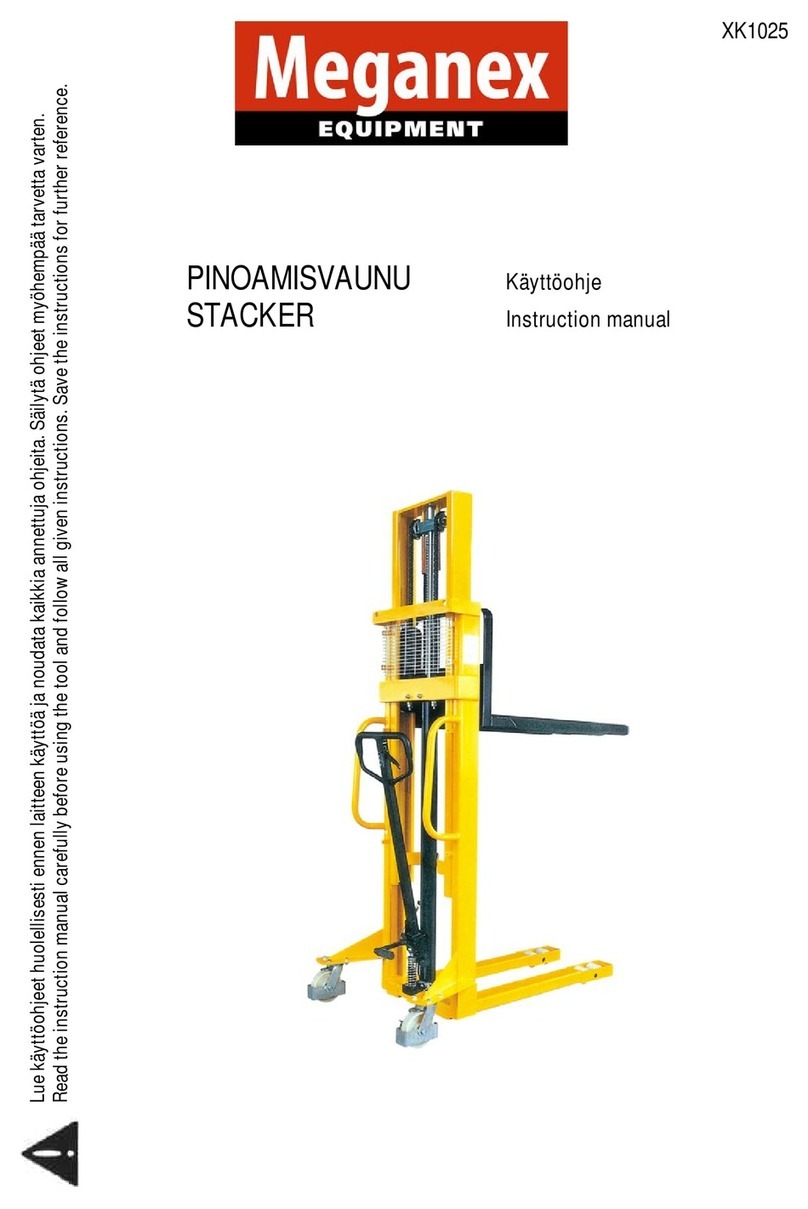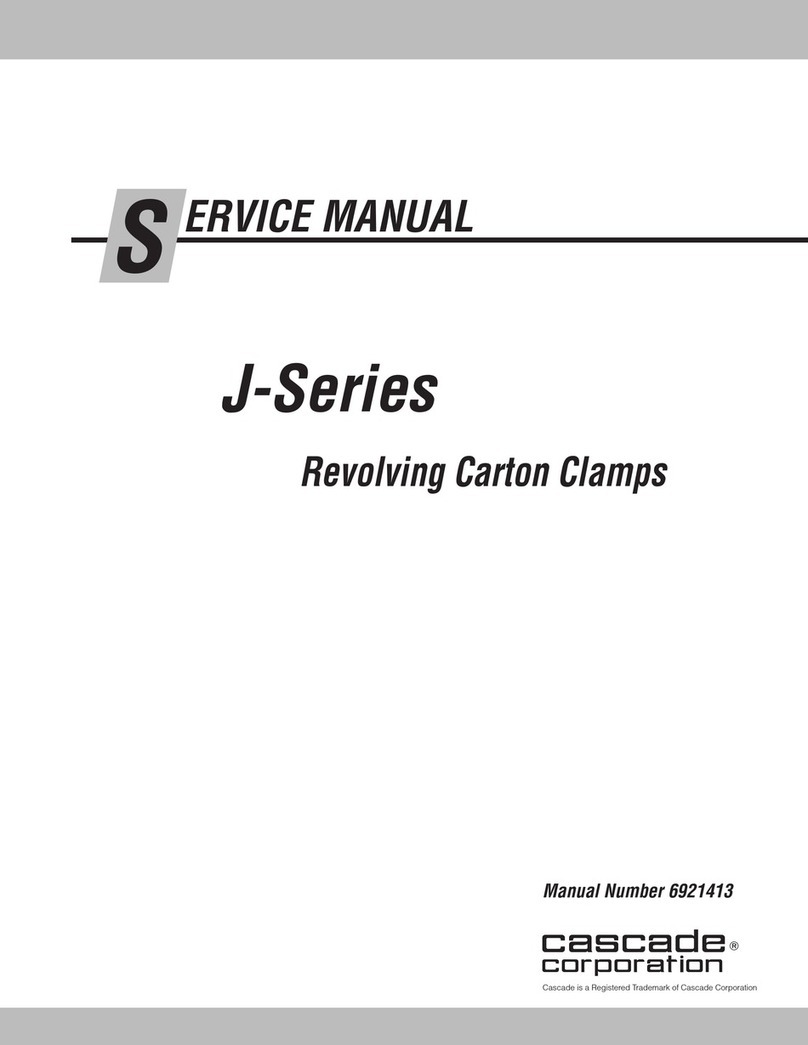Big Joe PDS 20 User manual

OPERATOR’S MANUAL
Big Lift LLC
www.bigjoeforklifts.com Manual Part No. 901635
08/16/2018
STRADDLE
LIFT TRUCK



4
FOREWORD
As a lifttruck operator, you are respon-
sible for a machine that is useful, pow-
erful, and can be hazardous if not
operated as described. Your Big Lift
LLC truck may weigh more than some
cars,dependingonthemodel.Observ-
ingandpracticingthesafetywarningsin
this manual cannot be overempha-
sized.Justknowingthewarnings,how-
ever, is no substitute for common
sense.Focusingonthetaskathand,in
almost all cases, prevent accidents.
Think of the truck as your own. In this
way you will learn its capabilities and
limitations.
This manual is intended to remain with
the truck at all times as a handy refer-
enceguidetooperation.Detailedmain-
tenance procedures are found in the
parts and service manual for the spe-
cific truck model, and are to be per-
formed only by a qualified technician.
For further information on obtaining a
completepartsandservicemanual,see
page 26 of this manual.
The operator who knows his truck will
learntospotproblemsastheydevelop.
Thisisaccomplishedbyperformingthe
Daily Checks and reporting any prob-
lems to the designated authority.
TABLE OF CONTENTS
SAFETY SYMBOLS..............................................................................................5
GENERAL DESCRIPTION....................................................................................5
NAME PLATE AND WARNING DECAL ...............................................................5
LOAD CAPACITY..................................................................................................8
BEFORE OPERATION..........................................................................................9
INSTRUMENTS AND CONTROLS - PDS 20/25/30/40, S22/25/S30..................11
INSTRUMENTS AND CONTROLS - PDI, PDM, PDH ........................................12
OPERATION........................................................................................................13
Forward and Reverse Travel and Speed Control ...............................13
Steering..................................................................................................13
Stopping.................................................................................................14
Parking...................................................................................................15
Battery Charging...................................................................................15
Load Handling .......................................................................................15
Moving a Disabled Truck......................................................................16
NOTICE - OBTAINING A PARTS AND SERVICE MANUAL..............................26

5
SAFETY SYMBOLS
WARNING and CAUTION are both signal words intended to alert the viewer to
the existence and relative degree of a hazard. They are both preceded by a safety
alert symbol consisting of an exclamation mark enclosed by a triangle.
A Warning indicates a hazard which could result in injury or death if proper pre-
cautions are not taken.
A Caution indicates a reminder of routine safety practices.
A prohibition slash (circle with diagonal slash through it) indicates a procedure or
action that should not be performed under any circumstances, as both personal
injury and/or damage to equipment will result.
GENERAL DESCRIPTION
The Big Lift LLC Straddle trucks utilize
the straddle leg configuration, which
normally straddles the load.
Control for steering, braking, forward
andreversetravel,hornandspeedcon-
trolarealllocatedonthecontrolhandle.
All trucks feature an automatic high
speed cut-off circuit which locks out
highspeedwhentheforksareelevated.
Trucks in this series may vary in load
capacity, battery arrangement, instru-
mentation and lift/lower controls,
depending on model and options. The
forks may be rigid or adjustable. One
model has a reach and tilt mechanism
whichextendstheforkstowardtheload,
then retractsand tilts back theforks for
transporting the load.
NAME PLATE AND WARNING DECAL
Warning decal locations may vary
betweenmodels, butnormallytheyare
nearthesteeringarmwithinsightofthe
operator.Thenameplateismountedon
thetruckframeormast.Seeillustration
on next pages
If the name plate or warning decal are
lost or damaged they should be
replaced immediately. Have your
supervisor or the designated authority
contact Big Lift LLC Authorized Dealer
for replacement.
Thename plate showsthemodelnum-
ber, serial number, and truck type. Bat-
tery type, with voltage and minimum
weight,isshownalongwithinformation
on the load capacity and load center.
The warning decal contains warnings
which also appear, with illustrations, in
the Operation section of this manual.

6
PDS 20/25 Name Plate and Warning Decal Locations - Typical
PDS 30/40 Name Plate and Warning Decal Locations - Typical
R6728
R7030

7
S22, S25 & S30 Name Plate and Warning Decal Locations - Typical
PDI, PDM & PDH Name Plate & Warning Decal Locations -Typical
R7031 R8308
R3965

8
This truck is equipped with a battery. Read and heed the following warning plus
any other warnings located near or on the battery. An example is shown here:
LOAD CAPACITY
The further the load center is from the
backrest, the lower the load capacity.
Theloadcentermust also be no higher
thanthatspecifiedabovetheliftingsur-
face (Top sideof forks). For example,a
load capacity of 3,000 pounds with a
loadcenterof24inchesmeansthatthe
truck can be used to lift 3,000 pounds
onlywhentheload’scenterofgravityis
nomorethan24inchesfromthefaceof
theforksor24inchesabovethetopside
of the forks. Note that a truck undergo-
ingspeedchangesisless stablethana
standing truck. If you are not sure that
the truck can lift a certain load, consult
your supervisor or the designated
authority.
WARNING:
R6115
R3814

9
Load Center
BEFORE OPERATION
The table on page 10 covers important
inspection points on trucks which
should be checked prior to operation.
Depending on use, some trucks may
require additional checks.
The illustration below shows a sample
formatforanOperatorChecklist,which
canbemodifiedasnecessarytofityour
operation.
Periodic maintenance of this
truck by a qualified service
technician is required.
A qualified service technician
should check the truck monthly
forproperlubrication,properfluid
levels, brake maintenance,
motor maintenance and other
areas specified in the parts and
service manual maintenance
section.
If the truck is found to be unsafe
and in need of repair, or contrib-
utes to an unsafe condition,
report it immediately to the des-
ignatedauthority.Donotoperate
it until it has been restored to a
safe operating condition. Do not
make any unauthorized repairs
or adjustments. All service must
beperformedbyaqualifiedser-
vice technician.
Sample of Operator Check List
WARNING:
WARNING:
WARNING:
R6235

10
Operator Checks
ITEM PROCEDURE
Transmission and hydraulic
systems Check for signs of fluid leakage.
Forks Check for cracks and damage and that they
are properly secured.
Chains, cables and hoses Check that they are in place, properly secured
and not damaged.
Guards and load backrest Check that safety guards are in place, prop-
erly secured and not damaged.
Safety signs Check that warning labels, nameplate, etc.,
are in good condition and legible.
Horn Check that horn sounds when operated.
Steering Check for binding or looseness in steering
arm when steering.
Travel controls Check that speed controls on control handle
operate in all speed ranges in forward and
reverse and that belly button switch functions.
Wheels Check drive wheel for cracks or damage.
Move truck to check load wheels and casters
for freedom of rotation.
Hydraulic controls Check operation of lift and lower to their maxi-
mum positions.
Brakes Check that brakes actuate when steering arm
is raised to upright position, and when lowered
to horizontal position.
PDI,PDM,PDH (w. Dynamic Brakes):
Check that dynamic brake (if so equipped - not
available on newer trucks) actuates when
dynamic brake pushbutton on control handle is
pressed.
Deadman/Parking brake Check that steering arm raises to upright posi-
tion when released and brake applies.
Battery disconnect Check that battery can be disconnected and
reconnected. Check for connector damage.
On the S22 & S25 check that the emergency
power disconnect is functioning properly.
High speed limit switch Allow for enough space to operate truck in
high speed. Elevate forks approximately two
feet, then test drive truck to check if high
speed is cut out.

11
INSTRUMENTS AND CONTROLS - PDS 20/25/30/40, S22/25/S30
The steering arm and control handle
provide controls for steering, forward
and reverse speed control, braking,
horn,andraisingandloweringtheforks.
Control handles on all models have a
“belly button” reversing switch which
reverses the direction of the truck upon
contact with the operator.
Detailed operating instructions are in
the Operation section of this manual.
A battery disconnect is mounted near
the steering arm. Pulling the gray dis-
connect on PDS trucks or pushing the
red disconnect plunger on S22 & S25
trucksremovesallpowerfromtruckcir-
cuits in the event of an emergency.
Control Handles
R8254 - PDS20-25, PDS30-40 (w.o. Side Shift), S22-25-30
R8255 - PDS30/40 (w. Side Shift) - Used up to Sn. S2315284
R8256 - PDS30/40 (w. Side Shift) - Used from Sn. S2315285

12
INSTRUMENTS AND CONTROLS - PDI, PDM, PDH
The steering arm and control handle
provide controls for steering, forward
andreversespeedcontrol,braking,and
horn. Control handles on some models
have pushbuttons for raising and low-
ering the forks, and for an additional
"dynamic brake" independent from the
mechanical brake.Control handles on
allmodelshave a "belly button" revers-
ing switch which reverses the direction
of the truck upon contact with the oper-
ator.
Detailed operating instructions are in
the Operation section of this manual.
A battery disconnect is mounted near
thesteeringarm.Pullingthedisconnect
removesall power from truck circuits in
the event of an emergency.
Control Handle - PDI, PDM, PDH
All models come standard with a lift/
lower control lever mounted near the
steering arm. Some models have addi-
tional control levers for operating a
reach and tilt functions which move the
forksout or in, and tilt the fork tipsupor
down.
Lift/Lower Control Level
Optional Features
Theoptional remote lift/lowercontrol(if
equipped) allows the operator to raise
andlowertheforkswhilestandingaway
from the control handle.
Optional Remote Lift/Lower Control
Other options are the battery capacity
indicator, hourmeter and keyswitch
whichmountonthepanelnearthecon-
trol handle. The battery capacity indi-
cator monitors the battery discharge
rate to indicate the remaining battery
capacity. The hour meter records the
accumulated hours that electrical
energy is being drawn from the battery
to run the pump and drive motors. The
keyswitch provides added security to
thetruck, preventingunauthorizedper-
sonnel from operating the machine.

13
OPERATION
Forward and Reverse Travel and Speed Control
Control Handles
All directional and speed controls are
located on the control handle.
Forward and reverse are controlled by
rotating the speed control lever as
shown. The lever is spring loaded to
returntoneutralwhenreleased.Further
rotation in either direction will progress
the truck from slow to maximum travel
speed.
Tochangedirectionsortostopthetruck,
rotate the speed control lever in the
opposite direction. The truck will come
to a stop and then, unless the controls
are returned to the center neutral posi-
tion, accelerate in the opposite direc-
tion.
Steering
Moving the control handle (which con-
nectstothesteeringarm)rightorleftwill
turnthetruckrightorleft.Whenmaneu-
vering around corners, make square
turns and be sure there is
adequate clearance.
R8257

14
Stopping
Stopthetruckasgraduallyaspossible.
Unnecessary rapid stopping could be
hazardous. Load could become unsta-
ble.
You can use plugging to stop the truck,
this electrical braking function consists
ofrotatingthespeedcontrolleverinthe
opposite direction of travel and then
releasing it when the truck stops. Plug-
ging is a convenient way to stop the
truck during normal operation. If the
control is not released, the truck will
accelerate in the opposite direction.
You can also stop the tucks movement
(forward or reverse) by raising the con-
trolhandletotheuppositionorpushthe
control handle all the way down. In
either positions, the travel controls will
deactivate and the brake will apply. To
releasethebrake,justmovethecontrol
handle to the operating position.
NOTE: The steering arm gas spring
automatically raises the
steering arm to the upright
position when the steering
arm is released.
CAUTION: If the control handle does
not raise immediately to
the vertical position when
released, the truck should
be placed “OUT OF SER-
VICE” until it can be
inspected by a qualified
repair technician.
PDI,PDM,PDH (w. Dynamic Brakes):
The Dynamic Brake (if so equipped - not
available on newer trucks) serves as a
secondarybrakingsystemcompletelyinde-
pendentfromthe mechanicalbrake.Press-
ingthedynamicbrakepushbuttonappliesa
constant DC voltage across the drive motor
field coils to stop the motor.
The dynamic brake pushbutton
shouldnotbeheldinplacelonger
thanone ortwoseconds.Exces-
sive use may blow the 40 Amp
fuse, which will render dynamic
brake inoperative.
Steering Arm Braking Positions
WARNING:
R6650 R3629

15
Parking
Whenparkingthetruck,donotobstruct
traffic lanes or aisles.
1. Park the truck in its designated
parking area.
2. Raise the steering arm until verti-
cal to apply the parking brake.
3. Fully lower forks and make sure
the lift carriage is all the way
down.
4. Turn keyswitch to off position.
Remove key for added security.
5. Pull the gray battery disconnect
or push red disconnect plunger
on S22 & S25 trucks.
Battery Charging
RefertoDOC245forbatterysafetyand
maintenance.
NOTE: Battery charging instructions
are contained in the service
manual.
Load Handling
Handle only loads arranged for
stability and always use caution.
Raise and lower the load
smoothlytopreventtheloadfrom
falling.
Alwaysbesuretheloadandload
center are within the capacity of
the truck. If in doubt check the
nameplate.
1. Approach the load slowly.
2. Stop the truck when the forks are
just in front of the load.
3. Adjust the forks to the maximum
practical width to support the load
to be lifted.If the truck has rigid
forks, position the truck so the
forks will give maximum support
to the load.
4. Raise or lower the forks until they
are properly aligned with the pal-
let openings.
5. Move the truck slowly into posi-
tion so that the forks are centered
about the load.
6. Make sure the load is against the
backrest and then raise the forks
until the pallet clears the rack.
7. Move the truck away from the
rack until the load clears the rack
and then lower the forks.
8. Always operate the truck with the
forks in the DOWN position and
slightly raised when operating on
a grade.
9. Lead the truck by the control han-
dle with the load trailing except
when in confined areas. Ramps
should always be traveled with
operator uphill of truck
.
10. Always look in the direction of
travel. Move slowly and check
clearances when approaching
obstructions.
WARNING:
WARNING:

16
11. Do not make sudden starts and
stops. Operate truck smoothly
and gradually.
12. Travel slowly and squarely
around corners. Remember that
the trailing load wheels do not fol-
low the turn path of the drive
wheel; instead, they tend to cut
the corner.
13. Line up the truck with the unload-
ing area.
14. Stop the truck and raise or lower
the forks until the pallet is in posi-
tion with the unloading area.
15. Check the load alignment with
surrounding objects.
16. Be careful not to damage or
move adjacent loads and objects.
17. Slowly move into position.
18. Lower the forks until the load is
securely settled on its own. Be
sure there is no downward force
on the forks on the rack or floor.
19. Carefully move the truck away
from the load watching to make
sure the load doesn’t move or
shift. If the load does move,
return the truck to the load and
reset.
NOTE: Make sure when working in a
rack area, that you do not
disturb another load while
placing yours in the rack.
This may cause a danger-
ous situation for other opera-
tors or pedestrians working in
this area later.
20. If forks are elevated, lower to
travel position.
Moving a Disabled Truck
Donotattempttomoveadisabledtruck;
notifyyoursupervisororproperauthor-
ity.
The following operating instructions appear on the truck warning decal, which is
located near the steering arm.

17
Do not operate this truck unless you have
been trained and authorized to do so, and
have read and understand all warnings
and instructions contained in this opera-
tor’s manual.
R6710
R6711
Do not operate this truck until you have
checkeditscondition.Givespecialattention
to wheels, horn, lights, battery, controller, lift
systems (including forks or attachments,
chains, cables and limit switches), brakes,
steering mechanism,
guards and safety devices. If you
have any questions, notify your
supervisor or proper authority.

18
Operate truck only from walking
position.
R3946
Never place any part of the body
into the mast structure.
R6713

19
R3948
Do not carry passengers.
Keep feet clear of truck
andalwayswearfootpro-
tection
R6715

20
R3950
Observe applicable traffic regulations. Yield right-of-way to pedestrians.
Slow down and sound horn at cross aisles and wherever vision is
obstructed.
R6717
Start, stop, travel, steer and brake
smoothly. Slow down for turns and on
uneven or slippery surfaces that could
causetrucktoslideoroverturn.Usespe-
cial care when traveling without load as
the risk of overturn may be greater.
This manual suits for next models
9
Table of contents
Other Big Joe Forklift manuals

Big Joe
Big Joe E30 User manual
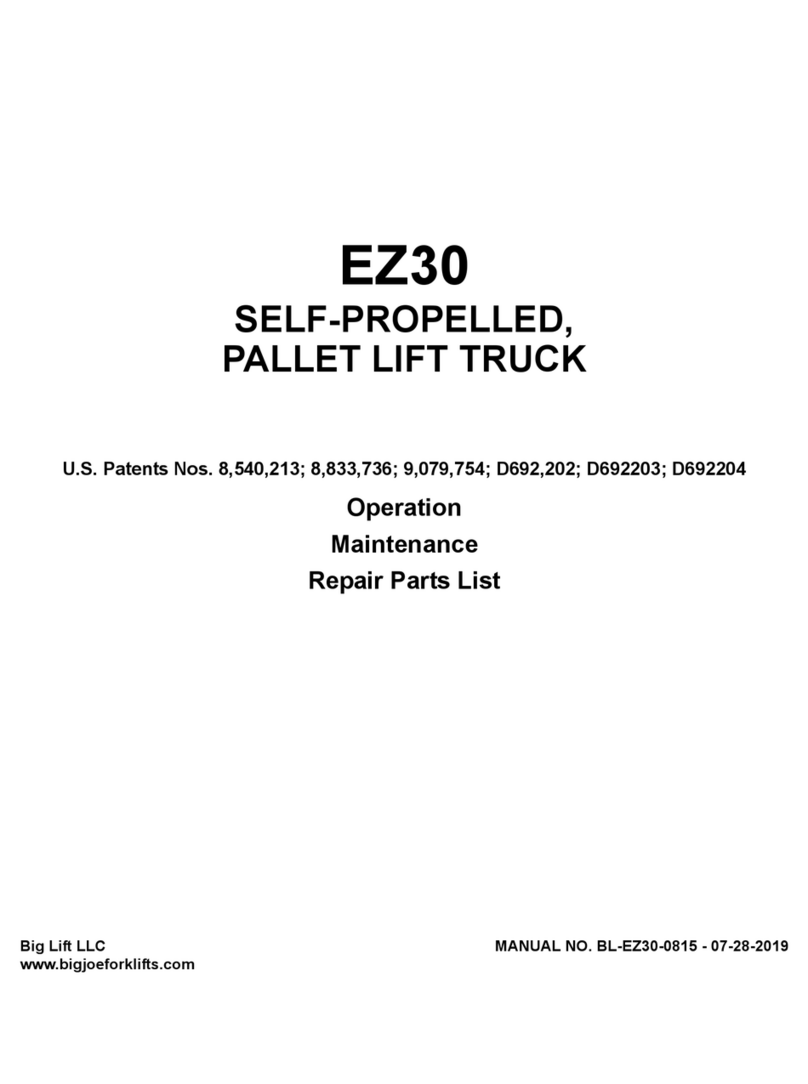
Big Joe
Big Joe EZ30 Use and care manual
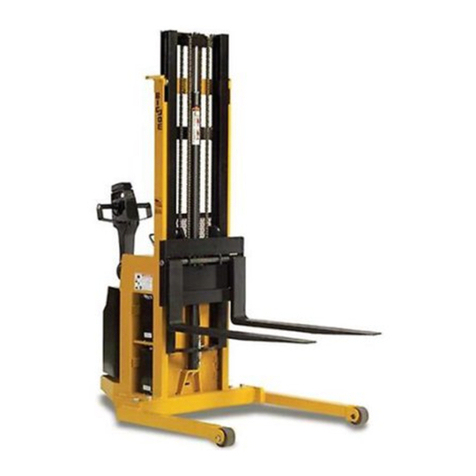
Big Joe
Big Joe PDI Series User manual
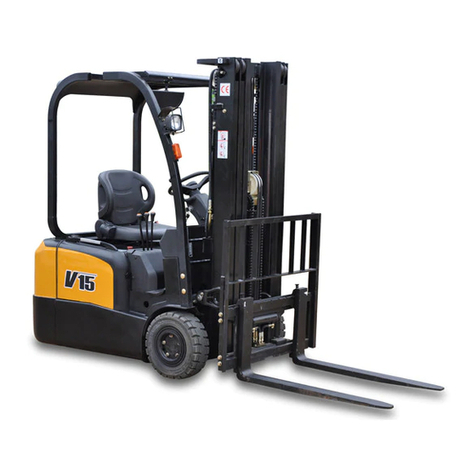
Big Joe
Big Joe V Series User manual
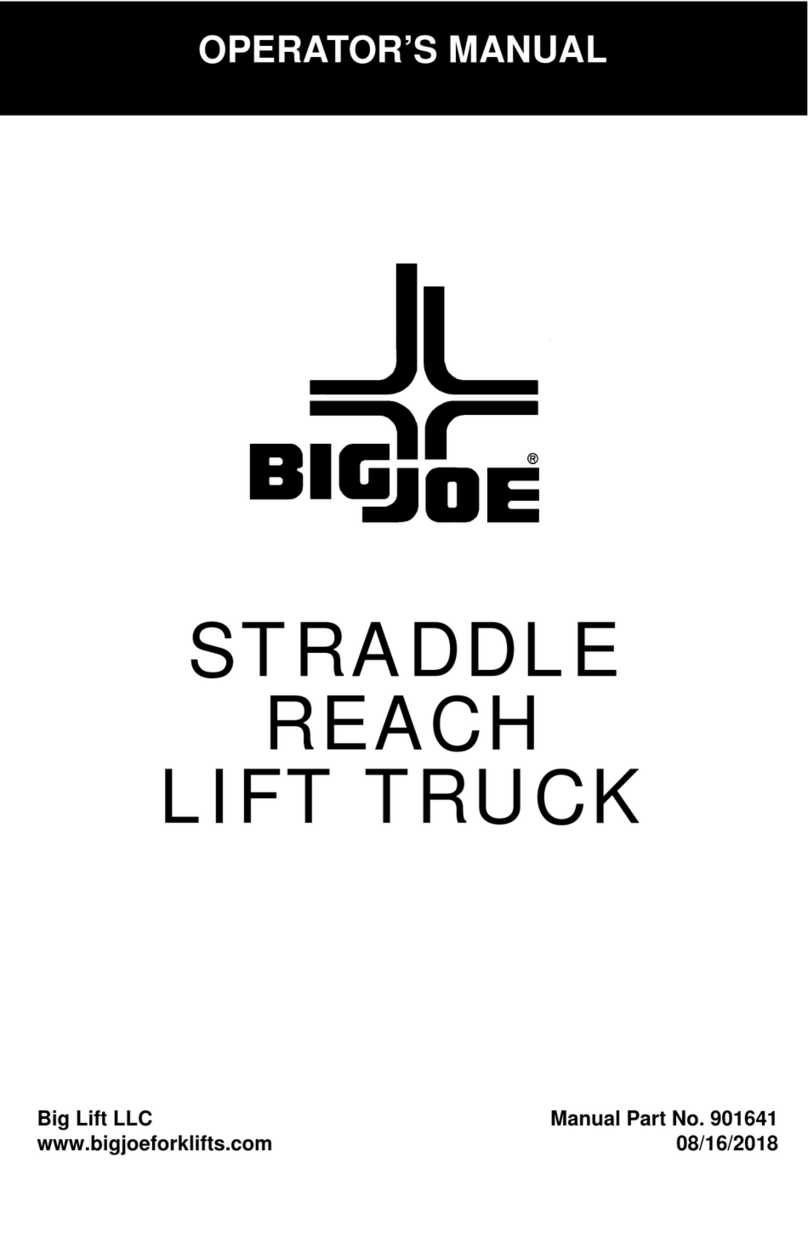
Big Joe
Big Joe PDSR User manual

Big Joe
Big Joe T15 User manual
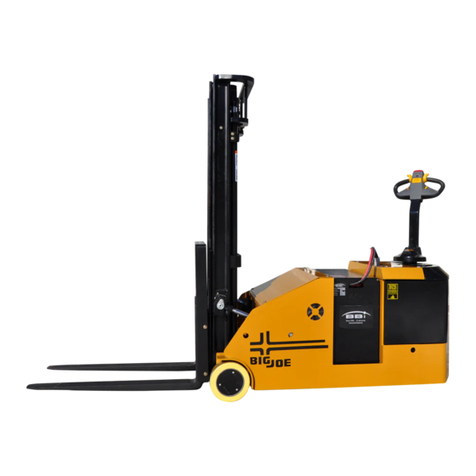
Big Joe
Big Joe CB33 User manual
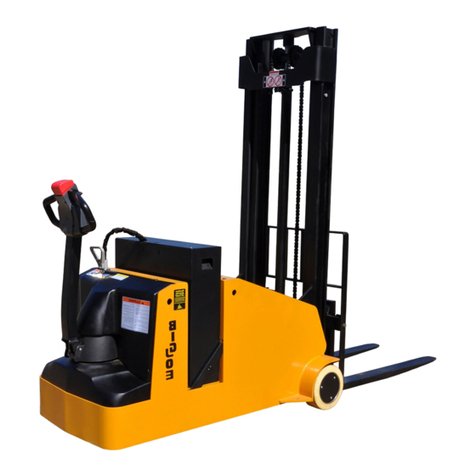
Big Joe
Big Joe CB22 User manual

Big Joe
Big Joe PPT 45 Series Use and care manual
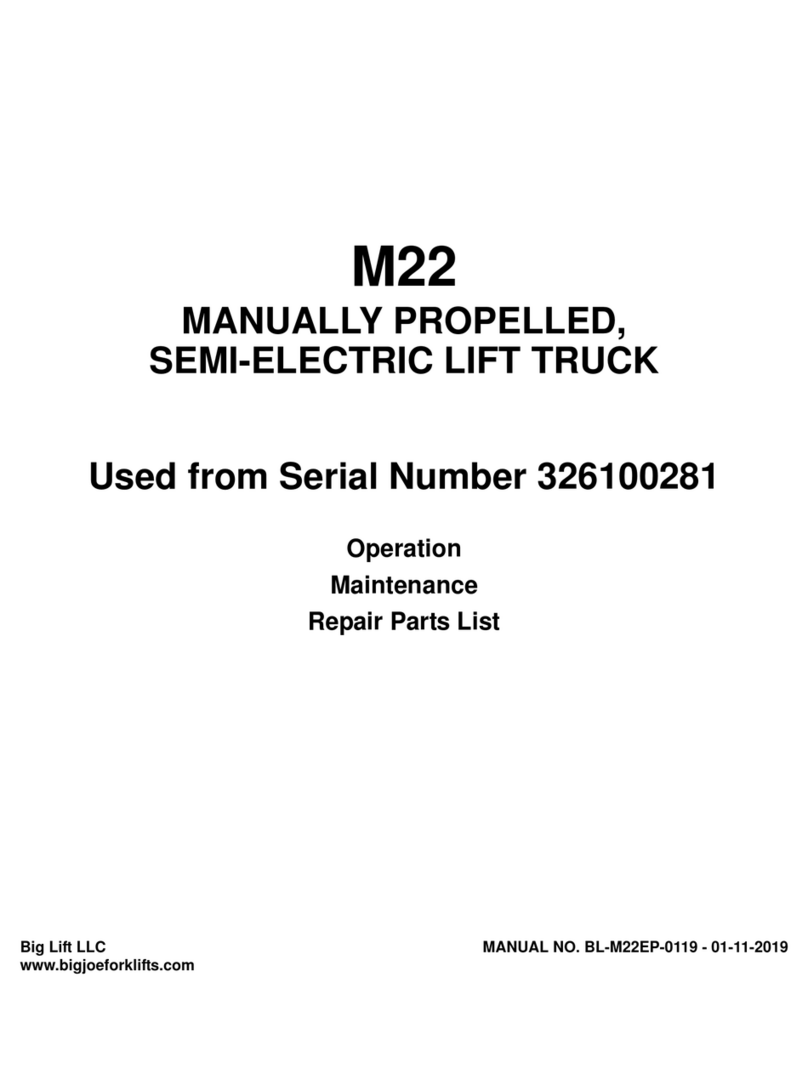
Big Joe
Big Joe M22 Use and care manual
